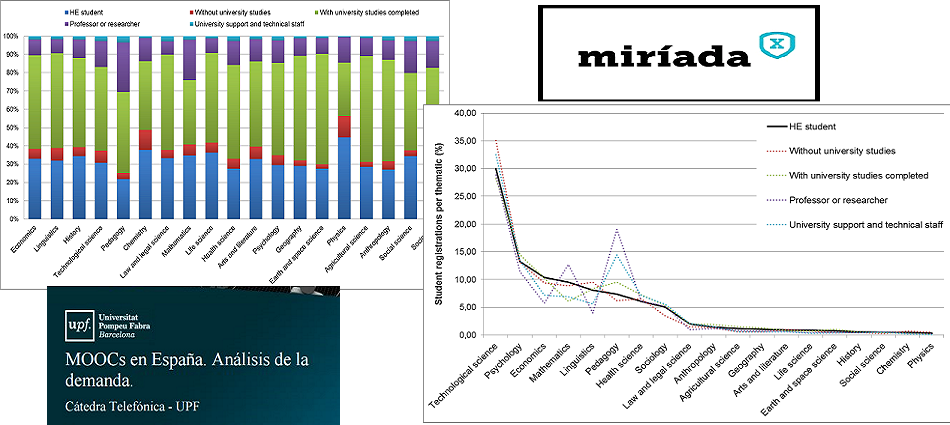
MiríadaX is the main Spanish MOOC provider, promoted by Telefónica, Universia and Banco Santander. MiríadaX offers MOOCs since 2013, most of them in Spanish, and few in Portuguese and English. In the context of the Cátedra Telefónica-UPF, where members of the RESET project participated, we have analyzed MiríadaX platform data up to the end of 2014, including data form 144 courses and 191,608 participants.
Part of the analysis, focused on understanding the behaviour of university students’ participation in MOOCs, will be presented at the eMOOCs conference in March 2016.
Albó, L., Hernández-Leo, D., Oliver, M. (2016) Are higher education students registering and participating in MOOCs? The case of MiríadaX. EMOOCs 2016 conference, Graz, Austria.
Abstract: Most MOOCs offer open learning opportunities at Higher Education (HE) level. However, it is still unclear how HE students are taking this type of course. This study focuses on the profile of HE students participating in MOOCs, their registration, preferred topics and completion patterns and how they compare to other types of participants. The paper presents a descriptive analysis of the MiríadaX platform data up to the end of 2014, including an analysis of 144 courses and 191,608 participants. Results indicate that current HE students, who are mostly Latin American and Spanish males interested in technology subjects,register for and complete lower numbers of MOOCs than participants who have already completed their HE studies. HE students older than standard ages have a significant presence in MOOCs and have higher numbers of MOOC registrations and completitions.
Conclusions of the study, in brief, include:
– The majority of university students involved in MiríadaX MOOCs are male (60.70%) in a range of 18-24. Interestingly enough, there is an important number of HE students participating in MOOCs with ages as from 24 (40%). Most HE students are from Latin American countries (57.5%) and Spain (41.01%).
- University students register for on average of 3.56 courses completing only 0.55 courses (similar pattern when comparing men and women).
- University students are taking MOOCs following a pattern of registration and completion of MOOCs in between participants without HE studies (lower numbers) and with HE studies completed (higher numbers).
- Within the collective of university students, those more active are older than 24, representing profiles of stronger intrinsic motivation to learn or to improve their professional competences.
- MOOCs in the technological science subject area, followed by psychology and economics, show higher percentages of registrations for all types of participants. In the physics subject area, university students represent the highest percentage of types of participants registered.
One interpretation of results is that MOOCs are generally perceived as useful lifelong learning opportunities and not that much as a resource (comparable e.g. to books) that can support the HE curriculum. The particular result for the case of physics subject may be explained by a use of these MOOCs as remedial (level O) courses for freshmen at universities. The recent initiatives on the use of MOOCs to support blended educational approaches may influence the future evolution of the trends identified in this paper.

A more extensive study is presented in a Cátedra Telefónica-UPF report (in Spanish). The report cover multiple aspects and all types of participants but it does not include a deep focus on a particular profile of participants (as in the previous paper). It provides and analysis of the social profile of individuals registering in MiríadaX courses, demand of courses by topic, and an analysis of drop-out rates.
Oliver, M.; Hernández-Leo, D.; Albó, L. (2015). MOOCs en España. Análisis de la demanda. Cuaderno de la Cátedra Telefónica-UPF “Social Innovation in Education”. Universitat Pompeu Fabra. Disponible online http://repositori.upf.
